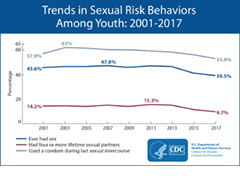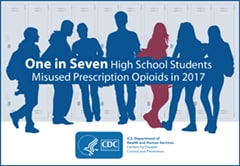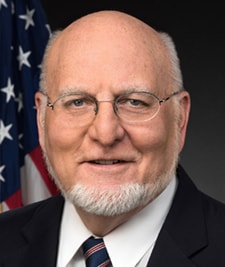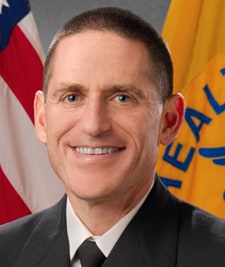CDC Data Provide Insights on the Risk of HIV & STDs Among Nation’s Youth
June 14, 2018 – 2017 YRBS: CDC Finds Fewer U.S. High School Students are Having Sex and Using Some Illicit Drugs – Still, Far Too Many Remain at Risk for HIV & STDs
The 2017 National Youth Risk Behavior Survey (YRBS) paints a promising picture about the drug and sexual behaviors U.S. high school students report, but the findings leave room for concern – especially among groups of young people who report multiple health risks.
-
- Press Release: Fewer U.S. High School Students Having Sex, Using Drugs–Too Many Still at Risk for HIV & STDs
- Trends Report: Youth Risk Behavior Surveillance: Data Summary and Trends Report, 2007-2017Cdc-pdf
- Data Summaries:
- Responsible Reporting Guide:
- MMWR: Youth Risk Behavior Surveillance — United States, 2017
Graphics:
These high-resolution, public domain images are ready to download and print in your publication. Click on a graphic to see it in high-resolution. For your convenience, we have included a table that contains the specific data from the report used to generate these charts. These images are in the public domain and are thus free of any copyright restrictions. As a matter of courtesy, we ask that the content provider be credited and notified of any public or private usage of an image.

View High Resolution Version
In 2017, there was another decline in the percentage of high school students who report that they have ever had sex (39.5%) and those who have had four or more sexual partners (9.7%) – the lowest levels since CDC began conducting the survey in 1991. However, condom use among sexually active students has decreased in recent years. In 2017, 53.8% of students reporting using a condom the last time they had sexual intercourse.

View High Resolution Version
Available for the first time, the survey found that 14% of U.S. high school students (1 in 7) reported misusing prescription opioids. The misuse of prescription opioids can lead to overdose as well as injection drug use, which increases the risk for HIV.

View High Resolution Version
Although adolescents are in good health overall, clear risks remain. The 2017 National Youth Risk Behavior Survey paints a promising picture about the drug and sexual behaviors U.S. high school students report, but the findings leave room for concern.
Spokespersons

“The health of our youth reflects the nation’s wellbeing. In the past decade, there have been substantial improvements in the behaviors that put students most at risk for HIV and sexually transmitted diseases. However, we can’t yet declare success when so many young people are getting HIV and STDs, and experiencing disturbingly high rates of substance use, violence, and suicide.”
– Robert R. Redfield, MD, director of Centers for Disease Control and Prevention

“Today’s youth are making better decisions about their health than just a decade ago. But, some experiences, such as physical and sexual violence, are outside their control and continue at painfully high levels. Their experiences today have powerful implications for their lives tomorrow.”
– Jonathan Mermin, M.D., director of CDC’s National Center for HIV/AIDS, Viral Hepatitis, STD, and TB Prevention

“We know that being connected to schools and safe adults is key to protecting the health of adolescents. Students are more likely to thrive if they feel safe and have a sense of belonging – and if they have parents, adults, teachers, and friends who they know care about their success.”
– Kathleen Ethier, Ph.D., director of CDC’s Division of Adolescent and School Health

“YRBS data help us identify newly emerging behaviors among the nation’s youth, while also tracking long-term behaviors over time.”
-J. Michael Underwood, Ph.D., chief of the School-Based Surveillance Branch within CDC’s Division of Adolescent and School Health

